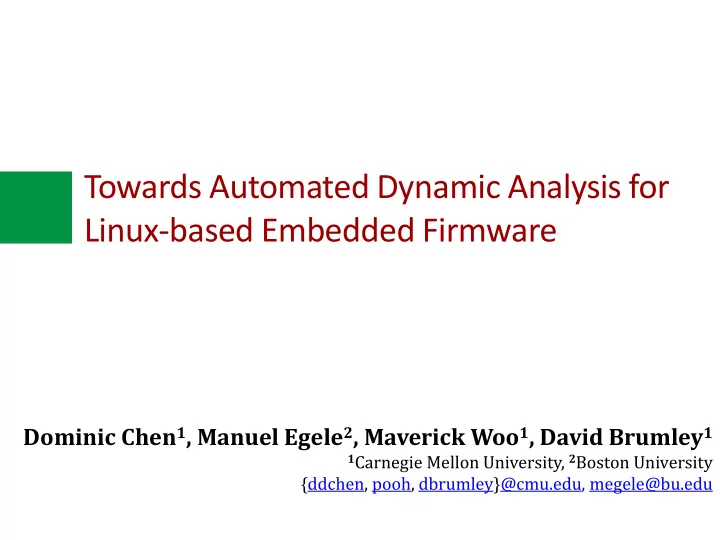

Towards Automated Dynamic Analysis for Linux-based Embedded Firmware Dominic Chen 1 , Manuel Egele 2 , Maverick Woo 1 , David Brumley 1 1 Carnegie Mellon University, 2 Boston University {ddchen, pooh, dbrumley}@cmu.edu, megele@bu.edu
2
FIRMADYNE • First system for full-system emulation of embedded Linux-based firmware • Provides large-scale automated dynamic analysis – Built-in vulnerability detection – Tested on 9.5k extracted firmware images • Objective: Continuous integration for firmware 3
Background • Embedded devices are important – Low visibility by end-users – Critical network infrastructure – Software rarely upgraded • Difficult to analyze – RISC-based architectures: MIPS, ARM, etc. – No direct interface into device firmware – Fixed hardware peripherals; no ‘Plug and Play’ – Significant variety; hard to scale 4
Firmware Architectures 5000 * 4500 4000 Number of Firmware Images * 3500 3000 2500 2000 1500 * 1000 500 0 MIPS ARM Unknown x86-64 PPC MIPS-64 x86 Other Big Endian Little Endian Unknown 5
Related Work • Zaddach et al ., “ Avatar: A framework to support dynamic security analysis of embedded systems’ firmwares ”, NDSS 2014 – Software emulation with partial offload to hardware – Doesn’t scale: requires hardware and connection to debug port • Costin et al., “ A large-scale analysis of the security of embedded firmwares ”, USENIX 2014 – Static extraction and analysis of firmware – Relatively cursory analysis and can’t verify results; classic trade-offs of false positives vs. false negatives 6
Dynamic Approaches • Application-level – Extract webpages and perform analysis – Custom interpreter modifications • Process-level – Emulate original applications in user-mode – Different hardware and execution environment • System-level – Boots entire filesystem with modified kernel – Supports all applications using original environment 7
FTP Sites Support Filesystem Kernel Websites MIPS Little-Endian Initial Architecture Emulation Identification eth0: 192.168.1.100 “ && cat 0 xDEADBEEF” eth1: 10.0.0.1 eth2: 128.2.42.52 Network Network Exploit Reachable Identification Verification 8
Filesystem Recovery • Firmware format is not standardized – Can be compressed, include photos, etc. • Solution : Develop custom extractor for filesystems – Searches for UNIX-like filesystems – Includes heuristics to avoid recursive extraction • Improved existing unpacking tools – jefferson: User-mode extractor for JFFS2 – sasquatch: Heuristic-based extractor for SquashFS 9
Device Configuration • Firmware requires NVRAM peripheral to boot – Used as volatile configuration store • Solution : Emulate NVRAM peripheral with userspace library – Compatible with different C runtime libraries – Self-initializes with default NVRAM values used during factory reset 10
Network Inference • Devices expect different network configuration – eth0 vs. lan0, wlan0, wan0, vs. ath0, br0, etc. • Solution : Use custom kernel with software instrumentation to infer networking – Parse kernel log to infer expected configuration – Track IP addresses, bridges, and VLANs – Restart with new configuration 11
Automated Analyses • Accessible Webpages – Checks for unauthenticated webpages – Command injection/information disclosure • SNMP Information – Dumps public SNMP data – Information disclosure • Vulnerability Detection – Checks for presence of vulnerabilities 12
Firmware Analysis Progress by Vendor 6000 Number of Firmware Images 5000 4000 3000 2000 1000 0 Downloaded Extracted Architecture Initial Network Network Exploited Identified Emulation Inferred Reachable Other QNAP Polycom TRENDnet TP-Link OpenWrt ZyXEL Synology Tomato by Shibby D-Link Netgear 13
Vulnerability Analysis • Discovered 14 previously-unknown vulnerabilities – New vulnerabilities can be automatically tested across entire dataset – Selected 60 applicable vulnerabilities from Metasploit • Of 1,971 firmware images that were network reachable, 43%* (846) were vulnerable to at least one exploit – Estimated to affect 89+ different products * Corrected 14
Unknown Vulnerabilities • Discovered 14 unknown vulnerabilities that affect 69 firmware images across 12+ products using our analyses – Command Injection (Netgear) – Buffer Overflow (D-Link) – Information Disclosure (D-Link & Netgear) • Responsible disclosure to vendors and CERT – VU#548680: Affected D-Link devices – VU#615808: Affected Netgear devices • Fix is expected by end of February/mid-March 15
Netgear Command Injection (CVE-2016- 1555) • Unauthenticated webpages with debug functionality were accidentally included – Used to write manufacturing data, e.g. MAC addresses, firmware region, and serial number – Can detect with our instrumentation • Form input is passed directly as command- line argument to shell – Affects 65 firmware images across 7+ products 16
D-Link Buffer Overflow (CVE-2016-1558) • Web server sets dlink_uid cookie to track sessions for authenticated users – Value is passed to strlen() then memcpy() • Setting the cookie to a long string crashes the web server at e.g. 0x41414141 – Affects 13 firmware images across 5+ products 17
D-Link & Netgear Information Disclosure • Unauthenticated services provide sensitive information – Web pages (CVE-2016-1556) – SNMP queries (CVE-2016-1557, CVE-2016- 1559) • Insecure default configuration – Affects 54 firmware images across 10+ products 18
Code Reuse • Sercomm Backdoor (CVE-2014-0659) – Unauthenticated remote attackers can dump configuration – Affects 282 firmware images across 16+ products from our dataset – Our results show On Networks and TRENDnet are also affected • MiniUPnPd Denial of Service (CVE-2013-0229) – Parsing flaws in open-source internet-facing UPnP daemon – Affects 169 firmware images across 14+ products from our dataset • OpenSSL ChangeCipherSpec (CVE-2014-0224) – TLS implementation allows attacker to downgrade cipher – Affects 169 firmware images across 27+ products from our dataset 19
Classification of Tested Vulnerabilities 5% 4% 33% Authentication Bypass 16% Backdoor Buffer Overflow Command Execution Cryptographic Flaw Denial of Service File Upload Information Disclosure 1% 7% 1% 33% 20
Conclusion • FIRMADYNE allows full-system emulation and dynamic analysis of Linux-based firmware – Infers network configuration of firmware – Emulates hardware peripherals, e.g. NVRAM – Automatically checks for vulnerabilities across dataset • 43% of all network reachable firmware images are vulnerable to at least one exploit – Future work in investigating code sharing among OEM’s • Open-source and available today – https://github.com/firmadyne – Patches welcome! 21
Questions • Dominic Chen (ddchen@cmu.edu) 22
Recommend
More recommend